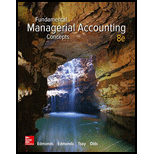
a.
The product that must be manufactured or sold if the demand is greater than the company’s capacity.
a.
Explanation of Solution
Scarce resource utilization: It is a decision is a result with respect to the superlative utilization of scarce resources in order to boost the net income of a business. Scarcity of various resources positions imperatives on the measure of item that can be created utilizing those resources.
Outsourcing: It can be termed as conveying all or part of an activity to a supplier or a provider. While outsourcing was initially limited to fundamental activities, it as of now invades the administration of numerous organizations.
Opportunity cost: Opportunity cost is the forfeit of certain benefits such as cost savings, incomes, which is surrendered by not picking an option. Opportunity costs are applicable in decisions where the acknowledgment of one option disqualifies the likelihood of selecting different alternatives.
The product that must be produced or sold if the demand is higher than the company’s capacity is as follows:
While Product N manufactures a greater greater contribution margin per unit, the thought should likewise be given to the labor that it takes to create every item. This can be practiced by estimating the contribution margin per labor hour.
Determine the contribution per margin for each product
Therefore the contribution per margin for Product M is $12 and Product N is $15.
Determine the contribution margin per labor hour for each product
Therefore the contribution margin per labor hour for Product M is $4 and Product N is $3.
From the results obtained above, according to the contribution margin per labor hour, Product M should be produced.
Therefore Product M should be produced.
b.
The product that should be manufactured or sold if the products are sold to the public in retail stores.
b.
Explanation of Solution
The product that must be manufactured or sold if the products are sold to the public in retail stores is as follows:
Since the company can stock one item as a result of limited floor space, the item that provides the higher total contribution margin should be selected. Unmistakably, Product N has the greater contribution margin per unit. However the company can sell additional units of Product M.
Determine the total contribution margin for each product
Therefore the total contribution margin for Product M is $96,000 and Product N is $105,000.
From the results obtained, Product N has the greater contribution margin per unit and the greater total contribution margin. Hence, Product N should be sold.
Therefore Product N should be sold.
c.
The product that should be produced or sold if the company can sell all the products it produces.
c.
Explanation of Solution
The product that should be produced or sold if the company can sell all the products it manufactures are as follows:
While Product N has the greater contribution margin per unit, the thought must be provided to the machine hours necessary to create the items. This can be achieved by figuring the contribution margin for a machine hour. According to the contribution margin per machine hour, Product M should be created. Provided that the company has a highest capacity of 24,000 machine hours and can trade every one of the items it manufactures, Product M will expand the profits by $72,000 where Product N can just build the profits by $60,000.
Determine the total contribution margin per machine per hour for each product
Therefore the total contribution margin per machine per hour for Product M is $3 and Product N is $2.50.
Determine the increase in profit for each product
Therefore the increase in profit for Product M is $72,000 and Product N is $60,000.
From the results obtained, Product N makes higher profit per unit, yet the productivity relies upon the quantity of machine hours associated with creating the item. Product M manufactures a higher profit for each machine hour since it takes less machine hours to manufacture. Hence Product M should be produced.
Therefore Product M should be produced.
Want to see more full solutions like this?
Chapter 6 Solutions
Fundamental Managerial Accounting Concepts
- IKEA labs is evaluating it's Dermex division investment centre.arrow_forwardSummit Industries' accounting records reflect the following inventories: Dec. 31, 2021 Dec. 31, 2020 Raw materials inventory: $250,000 $230,000 Work in process inventory: $350,000 $300,000 During 2021, $500,000 of raw materials were purchased, direct labor costs amounted to $600,000, and manufacturing overhead incurred was $520,000. Calculate Summit Industries' total cost of goods manufactured in 2021.arrow_forwardBrahma Manufacturing uses a job order cost system and applies overhead based on estimated rates. The overhead application rate is based on total estimated overhead costs of $310,000 and direct labor hours of 10,500. During the month of March 2022, actual direct labor hours of 11,200 were incurred. Use this information to determine the amount of factory overhead that was applied in March. (Round the answer to the nearest whole dollar.)arrow_forward

 AccountingAccountingISBN:9781337272094Author:WARREN, Carl S., Reeve, James M., Duchac, Jonathan E.Publisher:Cengage Learning,
AccountingAccountingISBN:9781337272094Author:WARREN, Carl S., Reeve, James M., Duchac, Jonathan E.Publisher:Cengage Learning, Accounting Information SystemsAccountingISBN:9781337619202Author:Hall, James A.Publisher:Cengage Learning,
Accounting Information SystemsAccountingISBN:9781337619202Author:Hall, James A.Publisher:Cengage Learning, Horngren's Cost Accounting: A Managerial Emphasis...AccountingISBN:9780134475585Author:Srikant M. Datar, Madhav V. RajanPublisher:PEARSON
Horngren's Cost Accounting: A Managerial Emphasis...AccountingISBN:9780134475585Author:Srikant M. Datar, Madhav V. RajanPublisher:PEARSON Intermediate AccountingAccountingISBN:9781259722660Author:J. David Spiceland, Mark W. Nelson, Wayne M ThomasPublisher:McGraw-Hill Education
Intermediate AccountingAccountingISBN:9781259722660Author:J. David Spiceland, Mark W. Nelson, Wayne M ThomasPublisher:McGraw-Hill Education Financial and Managerial AccountingAccountingISBN:9781259726705Author:John J Wild, Ken W. Shaw, Barbara Chiappetta Fundamental Accounting PrinciplesPublisher:McGraw-Hill Education
Financial and Managerial AccountingAccountingISBN:9781259726705Author:John J Wild, Ken W. Shaw, Barbara Chiappetta Fundamental Accounting PrinciplesPublisher:McGraw-Hill Education





